How to use MenuShrink to save MB of space
Original Page URL: https://www.dvdr-digest.com/articles/39_1.html
Author/Publisher: jmet
Date Added: Dec 13, 2005
Date Updated: Dec 13, 2005
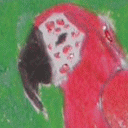
Software you will need: - MenuShrink 2.3 (or later)
Do you really need a fancy "Menu" with audio in the background? Is is worth sacrificing video quality? If you answered "NO" to either one of those questions, then MenuShrink is the program for you!
MenuShrink is a small application that lets you compress DVD motion menus by turning them into still images with or without background audio (removing the audio will allow for bigger savings). Best of all, it is completely free!
Menus can usually be shrunk down 5% to 10% of their original size, while keeping full functionality. That means you will decrease the amount of compression that is going to be needed, yet still retain the "Menu" feature of the DVD. (Wonderful tool for someone who wants to do a "Full Disc" backup!)
MenuShrink is extremely easy to use! All you do click the "Open" button and select the "VIDEO_TS.IFO" file or drag the "VIDEO_TS" folder on to the "MenuShrink" screen and click the "Process" button.
This is a basic guide to using MenuShrink 2.4 or later.
MenuShrink only open unprotected/unencrypted DVD files. You will need to have the full DVD structure, such as .VOB files, .BUP files, and .IFO files all together in a folder (preferably the VIDEO_TS folder). (Screen Shot Below)
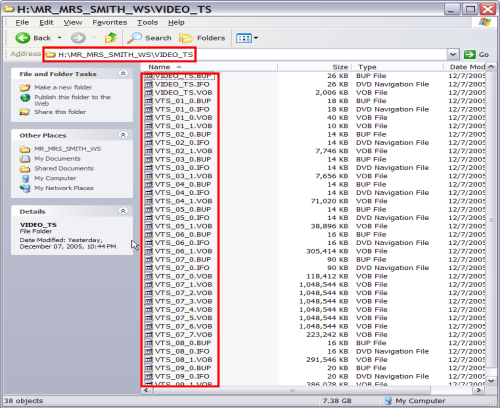
- Ok, lets start using MenuShrink! Start up MenuShrink. Click the "Open" button and select the "VIDEO_TS.IFO" file or go to "My Computer" and open up the folder that contains the DVD files. (Resize the "My Computer" screen so that both that screen and the MenuShrink screen are visible.) Now just drag the "VIDEO_TS" folder to the "MenuShrink" window.(Screen Shot Below)
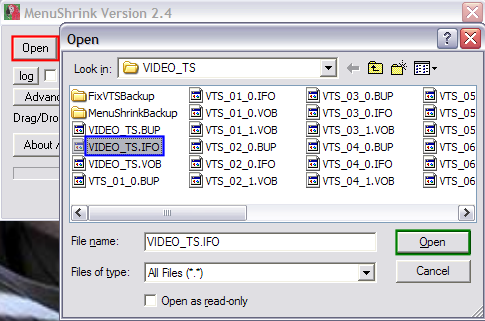
or
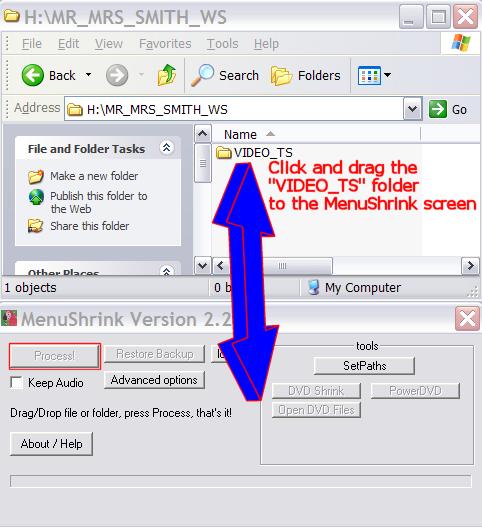
- After that, MenuShrink will load the DVD and tell you how many title sets (VTS) it found and the overall size of all the menus. As you can see, it found 117.63 MB (red). It will also tell you the total size of the DVD itself (blue). (Screen Shot Below)
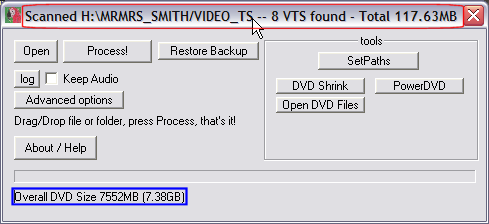
- *Optional* - You can decide whether or not you would like the background audio to be saved or eliminated from the menu. Of course, removing the audio (leaving the check mark out of the box) will allow for bigger savings. *Recommended* (Screen Shot Below)
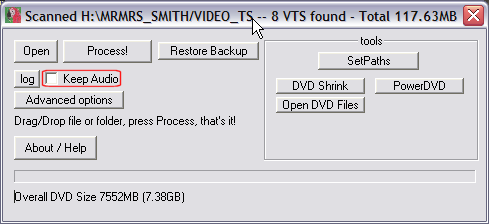
- Now click the "Process" button and MenuShrink will begin to "shrink" the menus down (in a matter of seconds). After MenuShrink completes, this screen will come up showing you the final menu size and how much space you have saved (blue). Also on that screen there are several buttons that you may click on to conveniently and automatically open up your DVD with your favorite editing or viewing programs, such as DVD Shrink and PowerDVD (green). There is also a "Restore Backup" button to click when you have messed up or would like to change some other settings (ie. you would want to keep the audio instead of remove it) (red). (Screen Shot Below)
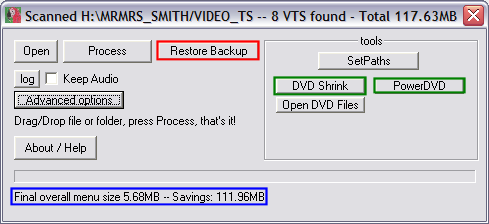
- Done! Continue as you normally would.
This is a more detailed explanation of how MenuShrink works and what some of the buttons do.
-
 - The open button really serves two purposes. - The open button really serves two purposes. - The first one being that it improved the GUI of the program for Windows machines (GUI = Graphical User Interface, which basically means its more "User Friendly").
- The second being that it was implemented solely for "Linux" machines in the Wine environment.
-
 - MenuShrink lets you define 7 buttons which you can link to your favorite tools using the Path panel. The two first buttons are normally for DVD Shrink and your Software DVD. The Path panel will show the default Shrink path. If that is not where DVD Shrink is located, change the path. The main MenuShrink window also has a button named “Open DVD Files” to open the DVD folder in explorer (shortcut F). Setting the path to your favorite software DVD player will enable the second button on the main MenuShrink window (which by default is set to "PowerDVD" but, if you don't have PowerDVD installed on your computer, it won't do anything if you click it. So you need to change the path for that button). Note that for this to work, the player application has to be able to open a DVD from its command line (MenuShrink passes VIDEO_TS.IFO as an argument). Media player classic (free!) can do that and so can PowerDVD 6.0 but PowerDVD 5.0 can’t and neither can WinDVD 5.0. - MenuShrink lets you define 7 buttons which you can link to your favorite tools using the Path panel. The two first buttons are normally for DVD Shrink and your Software DVD. The Path panel will show the default Shrink path. If that is not where DVD Shrink is located, change the path. The main MenuShrink window also has a button named “Open DVD Files” to open the DVD folder in explorer (shortcut F). Setting the path to your favorite software DVD player will enable the second button on the main MenuShrink window (which by default is set to "PowerDVD" but, if you don't have PowerDVD installed on your computer, it won't do anything if you click it. So you need to change the path for that button). Note that for this to work, the player application has to be able to open a DVD from its command line (MenuShrink passes VIDEO_TS.IFO as an argument). Media player classic (free!) can do that and so can PowerDVD 6.0 but PowerDVD 5.0 can’t and neither can WinDVD 5.0.
You can also set 5 additional tools which will open the VIDEO_TS.IFO file when you click on the corresponding button on the main window. I like to have PgcEdit, IfoEdit, and a second DVD player (just to check things work normally). These tools can also be launched via the F1-F5 keys.
To set up more buttons (programs) for MenuShrink to launch, click the "SetPaths" button and enter a new path in one of the blank boxes, blue boxes. (Note: the path needs to be the exact path of where the .exe file is located) I am going to add 2 buttons, one for my software DVD player, which is Media Player Classic and one for PgcEdit, which is my DVD editing program. (The name of the button displayed depends on what the .exe file is named. HINT HINT red box) (Screen Shot Below)
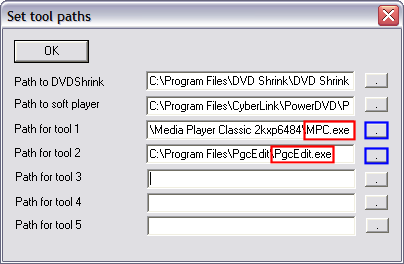
Now it should look like this after completing the previous step. (Screen Shot Below)
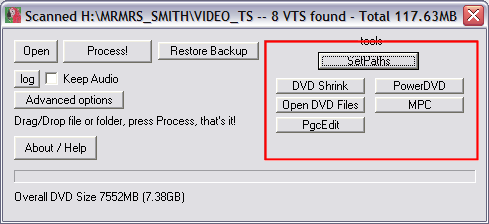
MenuShrink offers a few keyboard shortcuts listed below:- F1 through F5 to launch the tools defined in the Path panel.
- O to open the last DVD you processed.
- F to open the current DVD folder in explorer.
- E to open the INI file (with all your preferences) in the default text editor. This is for advanced users. Close MenuShrink before you save the INI file if you want your modifications to be saved (otherwise MenuShrink will overwrite the file).
- In the Preview Select panel, A to switch to Auto mode, and CTRL-K to kill playback, arrow keys to navigate.
 - This is where you can adjust which frames to select for the still menus, and make more advanced adjustments: - This is where you can adjust which frames to select for the still menus, and make more advanced adjustments:
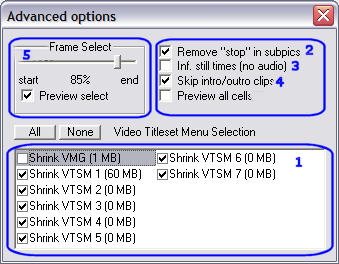
- All available menus (titlesets) are ticked by default. If you only wish to process certain menus, untick the ones you want MenuShrink to leave intact or click “None” and then select only the ones you’d like to process.
- You should leave the “Remove stop in subpics” option checked
- Decide whether you want the still menus to be displayed indefinitely (no-audio mode only). It’s best to leave this option unchecked in which case the menus will play for the same amount of time as they did originally
- You also have an option to skip menu intro/outro clips. These are the short video clips that are sometimes played before and after menus. Skipping them makes for a nicer smoother playback so you should select this option.
- You can use the Frame Select slider to decide where the still image should be taken from in the original menu. Move it all the way to the left to select the first image in the menu, all the way to the right to select the last image. The default position is 85%, which means the image is taken at 85% of the menu duration. Sometimes, the first or last images will be the clearest. Other times, the first image is black (fade-in) or the last one is (fade-out). Just experiment. If you don’t like your output, just try it again with different settings or switch to Preview-Select mode. You don’t even need to restore your backup as MenuShrink works on the files in its own special backup folder. If you use PowerDVD 6.0 or media player classic, this is where the “Soft DVD Player” button comes handy!
- If you prefer, you can select the still image by hand using the Preview. Check the “Preview Select” box to do that. When you click the Process button in the main window, a preview panel will pop up to let you chose the image for each menu cell. If you select Preview all cells, every cell that has more than 2 I-frames in it will open for you to preview it and select whether you want to kill it, shrink it or keep it animated.
 - By clicking the log button, you can view the output of the shrink. This contains useful information if you’re interested in the gory details! Warnings are marked in green text, while errors are marked in red text. - By clicking the log button, you can view the output of the shrink. This contains useful information if you’re interested in the gory details! Warnings are marked in green text, while errors are marked in red text.
 - If you goof up, don’t worry. Just click Restore Backup and all will be back as it was in a flash. You can do this at any time, even after the program has been closed and re-opened. - If you goof up, don’t worry. Just click Restore Backup and all will be back as it was in a flash. You can do this at any time, even after the program has been closed and re-opened.
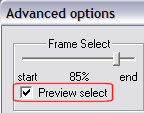 - In the Preview-Select mode, after you click Process, a preview dialog pops up for each menu cell that has buttons and has more than a couple images in it. This is to minimize the number of cells for which you need to manually select the frame. However, if you selected “Preview all cells” in the advanced options panel, even cells without buttons will be opened in the preview. - In the Preview-Select mode, after you click Process, a preview dialog pops up for each menu cell that has buttons and has more than a couple images in it. This is to minimize the number of cells for which you need to manually select the frame. However, if you selected “Preview all cells” in the advanced options panel, even cells without buttons will be opened in the preview.
The preview panel will be slightly different depending on whether the cell you’re previewing should normally be killed (because it’s a menu intro/outro and has no buttons, or only has NOP commands etc) or it’s a normal menu cell.
Here’s an example of a normal menu cell:
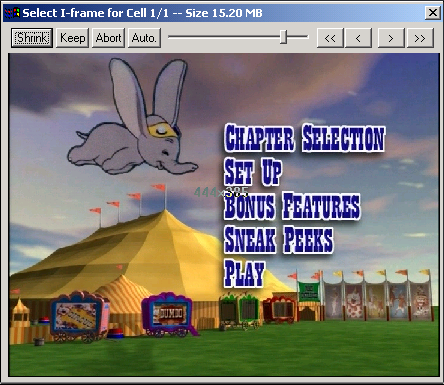
You can use the slider and the arrows to select which image you would like to use for this menu.
Clicking Shrink (or hitting Return) will validate the selection and let MenuShrink process the next cell. If you click Keep, the cell will not be shrunk and will remain animated (unprocessed). This is useful if you want to keep part of your menus animated, but shrink other parts to still menus. The size of the cell is indicated in the title bar (15.20 MB in this example) so you can decide whether or not it’s worth it to keep the cell.
If you click Abort, processing stops right here. If you click Auto, you will no longer be prompted to select the image for menus in the current Video TitleSet. In other words, if you were processing VTS 1 and you click Auto, the frame selection dialog will not open until VTS 2 is processed. This is useful if you just want to manually select the frame for a specific menu for which the default didn't’t work well. Once the frame is selected, click Auto to get the default frames for the rest of the menus in that VTS (and Auto again for other VTS if needed). The keyboard shortcut for Auto is the A key.
MenuShrink remembers which frames you selected manually. When you close MenuShrink, it will remember the selected I-frames of the last DVD you processed manually, so if you reload that DVD (for example using the shortcut O), your selections will show by default in the preview dialog. In this case, when you click Auto, your previous selections will be used, (or the default slider selection if you didn't’t select any frames).
Note: If you don’t click “Preview Select” in the advanced options panel, you get the default frames selected by the advanced options frame slider, not the frames you might have selected in a previous Preview-selection.
The preview dialog also offers a Kill option for advanced users. If you know that a specific cell is not a useful menu and that you can safely discard it, you can press CTRL-K. MenuShrink will ask you to confirm and then strip the audio from the cell, shrink it, and attempt to skip its playback, as it normally does for any cell that does not have buttons. Be careful though! If you kill a “good” menu by mistake, the DVD will not play normally. (You can always check that with the soft player button and of course, restore backup if you make a mistake).
Here’s an example of the preview panel for a menu intro:
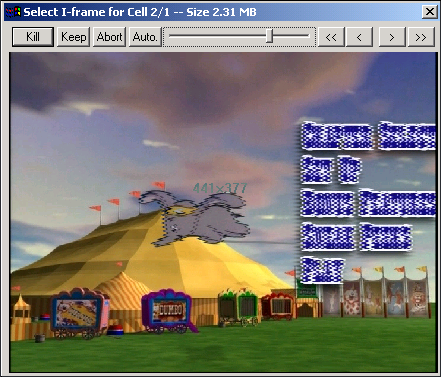
As you can see, the button names have changed: For these types of cells, you have the option to kill the cell (the default option, what would have happened if you had not selected to preview all cells), or to keep it animated. In both cases, the slider is useless, except to let you see what’s in the menu. The preview allows you to also keep animated menu intros/outros, or other videos that might have been put in the menu domain (interviews for example) and would normally have been killed by MenuShrink in automatic mode.
|







 - The open button really serves two purposes.
- The open button really serves two purposes.  - MenuShrink lets you define 7 buttons which you can link to your favorite tools using the Path panel. The two first buttons are normally for DVD Shrink and your Software DVD. The Path panel will show the default Shrink path. If that is not where DVD Shrink is located, change the path. The main MenuShrink window also has a button named “Open DVD Files” to open the DVD folder in explorer (shortcut F). Setting the path to your favorite software DVD player will enable the second button on the main MenuShrink window (which by default is set to "PowerDVD" but, if you don't have PowerDVD installed on your computer, it won't do anything if you click it. So you need to change the path for that button). Note that for this to work, the player application has to be able to open a DVD from its command line (MenuShrink passes VIDEO_TS.IFO as an argument). Media player classic (free!) can do that and so can PowerDVD 6.0 but PowerDVD 5.0 can’t and neither can WinDVD 5.0.
- MenuShrink lets you define 7 buttons which you can link to your favorite tools using the Path panel. The two first buttons are normally for DVD Shrink and your Software DVD. The Path panel will show the default Shrink path. If that is not where DVD Shrink is located, change the path. The main MenuShrink window also has a button named “Open DVD Files” to open the DVD folder in explorer (shortcut F). Setting the path to your favorite software DVD player will enable the second button on the main MenuShrink window (which by default is set to "PowerDVD" but, if you don't have PowerDVD installed on your computer, it won't do anything if you click it. So you need to change the path for that button). Note that for this to work, the player application has to be able to open a DVD from its command line (MenuShrink passes VIDEO_TS.IFO as an argument). Media player classic (free!) can do that and so can PowerDVD 6.0 but PowerDVD 5.0 can’t and neither can WinDVD 5.0.

 - This is where you can adjust which frames to select for the still menus, and make more advanced adjustments:
- This is where you can adjust which frames to select for the still menus, and make more advanced adjustments:
 - By clicking the log button, you can view the output of the shrink. This contains useful information if you’re interested in the gory details! Warnings are marked in green text, while errors are marked in red text.
- By clicking the log button, you can view the output of the shrink. This contains useful information if you’re interested in the gory details! Warnings are marked in green text, while errors are marked in red text. - If you goof up, don’t worry. Just click Restore Backup and all will be back as it was in a flash. You can do this at any time, even after the program has been closed and re-opened.
- If you goof up, don’t worry. Just click Restore Backup and all will be back as it was in a flash. You can do this at any time, even after the program has been closed and re-opened. - In the Preview-Select mode, after you click Process, a preview dialog pops up for each menu cell that has buttons and has more than a couple images in it. This is to minimize the number of cells for which you need to manually select the frame. However, if you selected “Preview all cells” in the advanced options panel, even cells without buttons will be opened in the preview.
- In the Preview-Select mode, after you click Process, a preview dialog pops up for each menu cell that has buttons and has more than a couple images in it. This is to minimize the number of cells for which you need to manually select the frame. However, if you selected “Preview all cells” in the advanced options panel, even cells without buttons will be opened in the preview.
